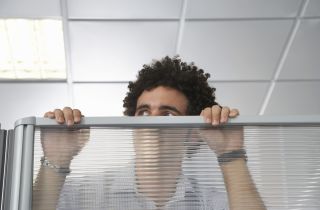Career
Why Our Cubicles Make Us Miserable
A body of research proves we need to be in the right space to do our best work.
Posted April 13, 2015 Reviewed by Gary Drevitch

Ask the average CEO how to optimize a workspace, and she might suggest you consult with an interior designer. Ask the same question of an evolutionary psychologist and he’ll direct you to a very different set of experts—our ancient ancestors.
Evolutionary psychologists argue that many of our current design preferences can be traced back to our shared history on the savannah. We’re drawn, they argue, to environments that promoted our survival as hunter-gatherers, and feel uneasy in situations that would have put our forefathers at risk. Such preferences are largely unconscious; we simply experience safe settings as pleasurable and dangerous ones as repellent, without being able to identify exactly why.
One example: Most of us instinctively enjoy sitting in sheltered locations that overlook expansive areas like parks and oceans. Think waterfront property (or apartments overlooking Central Park). In the past, the desire for settings that offered security and a view of our surroundings kept us alive and well-positioned to find our next meal. Locations offering prospect and refuge are inherently pleasing, while areas that deny us shelter or a view tend to generate discomfort.
We no longer need these features in order to survive, yet we can’t help but prefer them.
Brain-imaging research demonstrates the deep-seated nature of these preferences: Our desire for prospect and refuge is so strong, it even affects our perception of art. A 2006 study found that the pleasure centers of the brain consistently light up when we view landscapes, especially when their vantage point is one of refuge.
Our desire for safe locations also explains why sitting with our backs exposed can leave us feeling tense. We don’t enjoy having others sneak up on us and seek to minimize potential threats. As environmental psychologist Sally Augustin points out, this is one reason that restaurant booths fill up more quickly than free-standing tables. Mafia folklore has it that it’s best to sit with your back to the wall. It seems our ancient ancestors felt the same way.
Another evolutionary insight: We’re happiest when we’re close to the outdoors. As hunter-gatherers, being outside was essential to our survival. It meant proximity to food, water, and other people. And an extensive body of work reveals that nature is essential for psychological functioning. A 1984 study, for example, found that patients require fewer painkillers, and fewer days to recuperate from surgery, when assigned to a room overlooking trees. Scenes of nature, researchers argue, reduce our anxiety and lower muscle tension, which helps our bodies heal.
Having a view of the outdoors has also been shown to promote performance in the workplace. Employees who sit near a window are better at staying on task, show greater interest in their work, and report more loyalty to their company. A 2003 study found that when call center employees—who often rotate seats—are placed near a window, they generate an additional $3,000 of productivity per year. Research even suggests that the amount of direct sunlight entering an office can reliably predict the level of employee satisfaction in the workplace.
What is it about access to nature that makes us feel better?
Some experts believe exposure to natural sunlight plays a major role. Daylight regulates our circadian rhythms, affecting our bodies’ functioning. Deprived of sunlight, we experience an imbalance in serotonin and melatonin, upsetting our ability to get a good night’s sleep and compromising our immune systems. To wit, a 2013 study found that employees whose offices have windows sleep an average of 46 minutes more per night than those who labor in windowless rooms. Another study from the same year found that after the sun’s rays hit our skin, our bodies release nitric oxide, a compound that dilates the blood vessels and lowers our blood pressure.
Others believe that the benefits extend beyond the physiological. A number of researchers argue that natural settings are cognitively rejuvenating and help us restore our mental resources. In contrast to the overwhelming stimulation we often encounter at work, where we’re frequently inundated with calls, emails, and text messages for hours on end, natural settings engage our interest but demand very little of our attention. We have the freedom to let our minds wander, noticing as much or as little as we like, entering a state that psychologists term “soft fascination.” The result is an elevation in mood as well as replenished mental energy that improves our memory and enhances creativity.
Studies show that the mere presence of plants can also provide surprisingly large benefits. Office workers report feeling healthier and more energized when their workplace features live plants and fresh flowers. A 2011 study found that randomly assigning participants to rooms with indoor plants led to significantly better performance on tasks requiring sustained attention and concentration.
When views and plants aren’t available, even reminders of nature appear to help. Research suggests that access to aquariums and fireplaces puts us at ease and opens us up to connecting with others. Pictures of landscapes make us less anxious. Brief exposure to blue and green, colors ever-present in fertile environments rich in vegetation, water, and nourishment, make us feel safe—and improve our creative output.
It’s not hard for the evolutionary psychologist to see why so many offices fail to engage their employees. Depriving people of sunlight, restricting their views, and seating them with their backs exposed is not a recipe for success—it’s a recipe for chronic anxiety. For that matter, so is placing workers in expansive rooms, inundating them with stimulation, and failing to provide them with an area for refuge where they can recover from attention fatigue.
We tend to assume that employee engagement is about the work—that so long as we give talented people challenging tasks and the tools to excel, they will be happy. But that formula is incomplete. Our mind responds to the signals in our environment. And the less comfortable we are while doing our work, the fewer cognitive resources we have available.
This is why design ultimately matters. It’s because engaging employees is about creating an environment that positions people to do their best work. Paleolithic Man may be long gone, but he can still teach us a few things when it comes to designing a better workplace.
Excerpted from The Best Place to Work: The Art and Science of Creating an Extraordinary Workplace.
Connect with me on Twitter @ronfriedman
LinkedIn Image Credit: Milles Studio/Shutterstock




